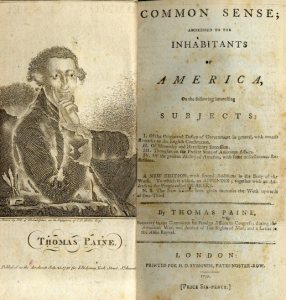
Thomas Paine was an English American journalist and political radical. Paine had a rather difficult start. He failed out of school at 12 and joined his dad’s business making ropes. However, Paine did not have the skills for that either. A few years later he worked as a tax officer but was discharged twice. With much frustration, Paine published his first work, The Case of the Officers of Excise (1772), disputing for a pay raise for officers. Little did he know, that his future wad headed in the direction of publication. At the age of 37 he ran into Benjamin Franklin in London who helped him immigrate to America. He arrived right around the time of the American Revolution. In Philadelphia, Thomas Paine flourished. He got a job as an editor for the Pennsylvania Magazine, where he eventually was able to publish some of his very famous works, including the pamphlet: “Common Sense,” which was an inspirational piece that helped spark interest in the American people to fight for independence from the British.

Thomas Paine has been credited with the writing of “African Slavery in America,” although it has not been confirmed. This particular piece is very different in both style and content in comparison to the writings of Paine, which is why some historians claim that this might not have been his work. The essay was published in the Pennsylvania Journal and the Weekly Advertiser and was signed under the anonymous name “Justice and Humanity.” This piece warns Americans about slavery and exposes the indecent capture and torture of enslaved individuals. The writer states with great objection, ”Our Traders in MEN (an unnatural commodity!) must know the wickedness of the SLAVE-TRADE…” The writer of this piece, which has been assumed to be Thomas Paine, raised several valid points throughout the essay. Africans were productive people. They were citizens of their own country before being enslaved by the English. This was the writer’s way to ensure a connection and establish a way for the American readers to develop a sense of humanity in their slaves. “The Managers the Trade themselves, and others testify, that many of these African nations inhabit fertile countries, are industrious farmers, enjoy plenty, and lived quietly, averse to war, before the Europeans debauched them with liquors, and bribing them against one another; and that these inoffensive people are brought into slavery, by stealing them, tempting Kings to sell subjects, which they can have no right to do, and hiring one tribe to war against another, in order to catch prisoners”. The writer of “African Slaves in America” mentions that all people are born with rights; however, enslaving them takes away those rights. He also challenges the readers who use biblical verses as a means to justify slavery. Whether this was written by Thomas Paine or not, the writer is clearly very persistent in these thoughts against slavery.
While the published piece of “African Slavery in America” was a very loud and public cry against slavery, Thomas Paine himself was a very quiet man regarding the subject. While he believed in antislavery, he left those thoughts to himself. He did not have much to say concerning slavery and he often avoided matters of abolition. Although he thought all men deserved freedom, he might have thought the subject of slavery to be very controversial. Being of English decent, who were largely responsible for the spread of the slave trade, Paine might not have felt himself to be a reasonable spokesman for the freeing of slaves. Paine most likely received his politics regarding slavery through his early years. He grew up in a Quaker family in Thetford, England. The Quakers were some of the first people to condemn slavery and the slave trade. Both in England and America, the Quakers expressed their beliefs in freedom for all men. Quaker societies cut ties with the slave trade and demanded that all men followed in their footsteps. Thomas Paine remained close to the roots, by seeking out the Quaker community in Philadelphia.
To summarize, Paine had no ties to slavery. He did not at any point in his life hold slaves. He was briefly a member of the Pennsylvania Society for Promoting the Abolition of Slavery and the Relief of Free Negroes Unlawfully Held in Bondage. His involvement was short has he only attended two meetings. While some historians say that he was a founding member in 1775, his name did not appear in any of the written records until his attendance at his only two meetings in 1787.Whether he was openly against slavery or not, Thomas Paine did have indicators in his life that leads to the assumption that he might have been a bit of an abolitionist.
Work Cited
“Thomas Paine: African Slavery In America.” Constitution Society. N.p., n.d. Web. 05 Mar. 2015.
“Thomas Paine Biography.” Bio.com. A&E Networks Television, n.d. Web. 03 Mar. 2015.
“Thomas Paine.” Ushistory.org. Independence Hall Association, n.d. Web. 04 Mar. 2015.